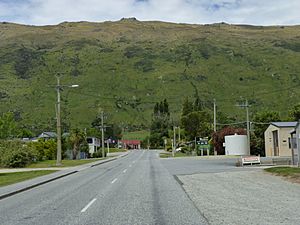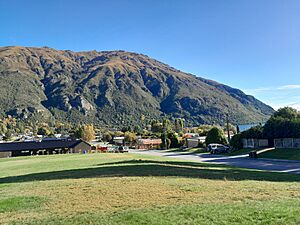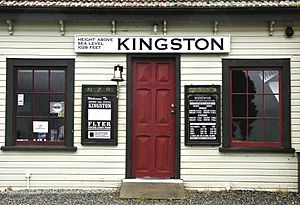Kingston, New Zealand facts for kids
Quick facts for kids
Kingston
|
|
|---|---|
|
Rural settlement
|
|

Kingston
|
|
| Country | New Zealand |
| Region | Otago |
| Territorial authority | Queenstown-Lakes District |
| Ward | Queenstown-Wakatipu Ward |
| Electorates |
|
| Area | |
| • Total | 0.60 km2 (0.23 sq mi) |
| Population
(June 2023)
|
|
| • Total | 390 |
| • Density | 650/km2 (1,680/sq mi) |
| Time zone | UTC+12 (NZST) |
| • Summer (DST) | UTC+13 (NZDT) |
| Postcode |
9793
|
| Area code | 03 |
| Local iwi | Ngāi Tahu |
Kingston is a small town located at the very southern tip of Lake Wakatipu in New Zealand's South Island. It sits just north of the border between the Otago and Southland regions.
Kingston is about 47 kilometres south of Queenstown. You can reach it by a road called "The Devil's Staircase," which is part of State Highway 6. This road winds between the lake on one side and The Remarkables mountains on the other. Kingston is also close to where the Mataura River begins.
The Story of Kingston
Kingston was not always known by its current name. It was first called 'St Johns'. This name was given in honour of a police commissioner named St John Branigan.
Who Lives in Kingston?
Kingston is considered a rural settlement by Statistics New Zealand. In 2018, about 306 people lived in the Kingston settlement area. The population has been growing steadily. For example, between 2006 and 2018, the number of people living here more than doubled.
Most people in Kingston are of European or Pākehā background. However, the town is also home to people of Māori, Pasifika, and Asian heritage, among others. This mix of cultures makes Kingston a diverse place.

Getting Around: Transport in Kingston
One of the most famous things linked to Kingston is the Kingston Flyer. This is a historic railway service that used to run on a special section of old train tracks.
The Kingston Flyer operated on a 14-kilometre part of the former Kingston Branch railway line. This line connected Kingston to the city of Invercargill for over 100 years. It first opened in 1878. The railway line stopped operating in 1979 after a storm damaged a section of the track.


